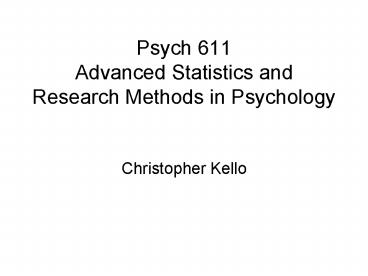Psych 611 Advanced Statistics and Research Methods in Psychology - PowerPoint PPT Presentation
1 / 22
Title:
Psych 611 Advanced Statistics and Research Methods in Psychology
Description:
Psych 611. Advanced Statistics and Research Methods in Psychology. Christopher Kello ... Skewness, kurtosis, central limit theorem, quartiles, outliers, difference ... – PowerPoint PPT presentation
Number of Views:609
Avg rating:3.0/5.0
Title: Psych 611 Advanced Statistics and Research Methods in Psychology
1
Psych 611Advanced Statistics and Research
Methods in Psychology
- Christopher Kello
2
(No Transcript)
3
Scale-Free Networks
- Internet connectivity
- Social ties
- Corporate holdings
- Semantic associations
- Biological / ecological networks
Previous picture taken from http//www.smu.edu/mat
h/netw.html
4
A simple law holds amidst all the complexities
of scale-free networks
5
Human Behavior
- Inherently complex and messy
- Often appears as noisy in data
- Yet often yields signals or patterns that are
informative about - Cognitive and social processes
- Clinical treatments, educational practices
- Opinions, attitudes, trends, etc.
6
Psychological Data
- Research Methods Ways of measuring behavior in
order to yield signals/patterns - Statistics Tools for finding signals/ patterns
in behavioral measurements
7
Who We Are
- Chris Kello
- Richard Hermida
- David Kidd
- Joe Luchman
8
Course Structure
- http//archlab.gmu.edu/people/ckello/psyc611fall07
.htm - Textbook
- Lectures
- Literature review
- Labs
- Exams
- Presentations
9
First Lecture
- Research methods and statistics are ALWAYS
fundamentally about variability - Within- and between-subjects variance
- Observed, expected, residual variance
- True variance vs. error variance
10
Methods and Statistics
- Are useless without well-formulated questions
and hypotheses - Questions spring from desires to know, help, fix,
improve, etc. - Questions MUST be posed so that observations can
answer them - Hypotheses are possible outcomes of pursuing a
research question - Often Hnull versus Hresearch
- Usually should have a basis in theory
11
Descriptive Statistics
- Are exploratory, they help to paint a picture
but not answer research questions by testing
hypotheses - Histograms, scatterplots, line and bar graphs,
many other types of graphs - Measures of central tendency, variance, relation,
deviations from normality - Dont underestimate the value of using
descriptive statistics, but use with caution
12
Frequency
Lateral Deviation
Lateral Deviation
Ordered Free Throws
13
Inferential Statistics
- Are designed to answer questions by testing
hypotheses - Inferences based on samples drawn from some
population - Different types come with different assumptions
that must satisfied in order to use them
14
Basic Design Types
- Experiments
- Independent vs. dependent variables
- Random sampling / random assignment
- Minimize error variance / confounds
- Test causal hypotheses
- Observational a.k.a. correlational studies
- Explore and examine relations among vars
15
Need to Know
- Formulas and concepts behind
- Mean, median, variance, standard deviation,
standard error of the mean, z-score, correlation
(z-score formula), covariance, linear regression
(z-score formula), coefficient of determination - Concepts behind
- Skewness, kurtosis, central limit theorem,
quartiles, outliers, difference between
correlation coefficient and covariance - Be able to interpret
- Histograms, box plots, scatter plots (positive,
negative, no linear relation, non-linear
relations)
16
www.ojp.usdoj.gov/.../documents/documentff.html
17
www.omninerd.com/2006/04/21/articles/50
18
Standardized Observed (Actual) Mean Reaction Time
Standardized Model (Expected) Mean Reaction Time
19
data.princeton.edu/stata/Introduction.html
20
(No Transcript)
21
Homework 1
- Collect at least 50 pairs of observations for an
empirical phenomenon you find interesting - Can be any kind of data, not just behavioral
- Observations must be integers or reals
22
- Write a brief report (500-700 words)
- Introduction
- Lead reader into your research question and
hypotheses with motivation / background, striving
to achieve the aims listed on Methods and
Statistics. - Methods
- How observations were collected, design params in
the terms listed on First Lecture, Inferential
Statistics, and Basic Design Types overheads. - Results
- Report / graph / address everything listed on
Need to Know overhead (use z-score scatter plots) - Discussion
- What were the most interesting / least boring
aspects of the results? What can one take away
from these results?































